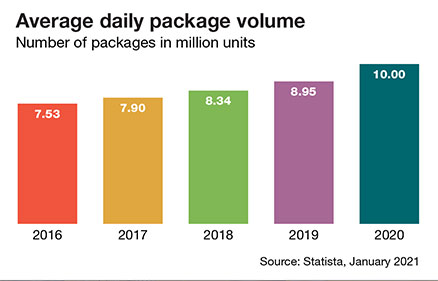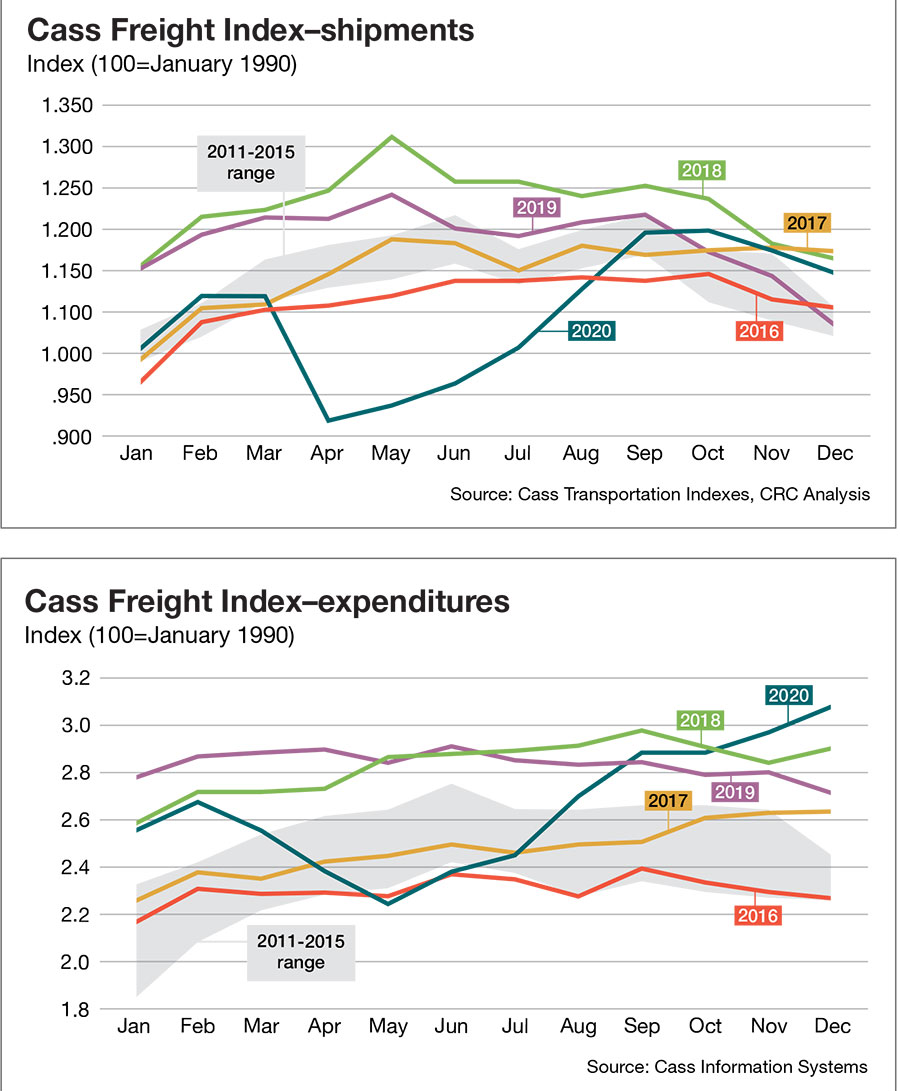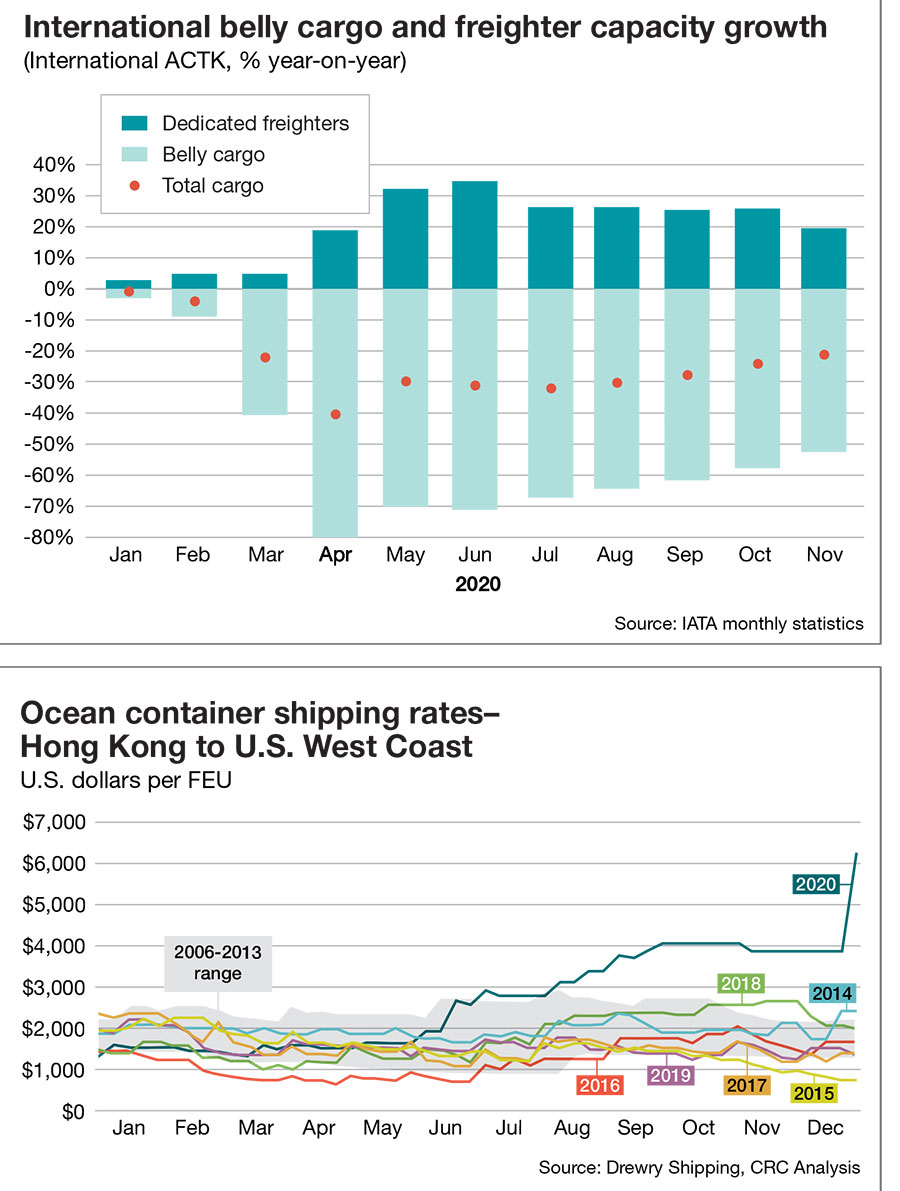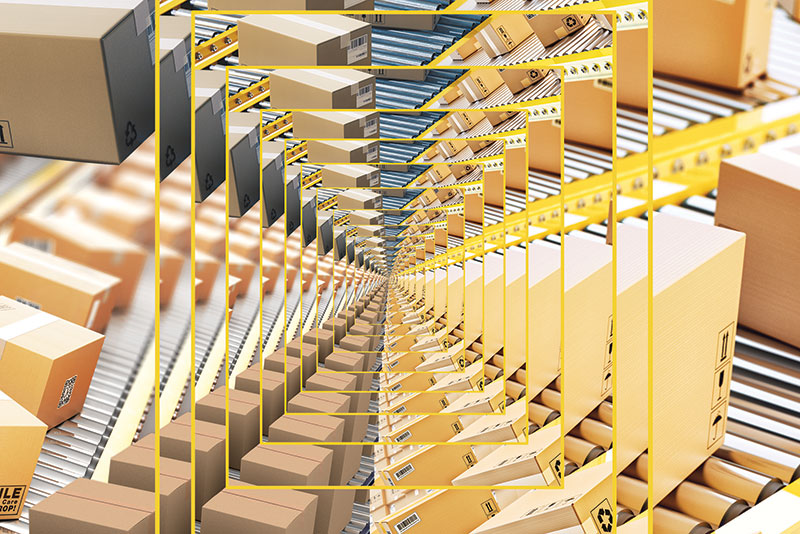E-commerce Boom: Welcome to the new reality
The increased e-commerce volume generated by the pandemic has no end in sight—and signals a permanent behavioral shift of an indeterminate magnitude. In fact, it has provided an opportunity for carriers, vehicle manufacturers and tech companies to research, test and invest in alternative ways to provide pick up, transport, sortation and delivery.
Mark Twain famously said: “There are three kinds of lies: lies, damn lies and statistics.”
Sorting through the wheat and chaff of the numbers and opinions and getting to what’s really going on can be challenging. The rapid rise of e-commerce, coupled with the lightning-like spread of COVID-19 is certainly not breaking news, as e-commerce sales continue to soar in concert with the opposite effect on brick-and-mortar sales.
Amazon continues to be the 900-pound gorilla in retailing and is amping up their presence in the logistics space with their own fleet of planes, trailers and delivery trucks. According to Gartner, “Globally, there are 3 million sellers on Amazon out of 7.1 million total online retailers.”
The key, unanswered question is how much of this will “stick” once the pandemic has passed and people seek to return to some form of normality. Opinions vary, but there is general consensus that traditional approaches to work—commute-office-commute—are unlikely to ever go back to what they were pre-COVID. Whether this affects on-line shopping from home remains to be seen.
We spoke to a number of veteran experts from all modes, in and around the transport business to gather their points of view on what this all means now and in the future. If there are a few themes to be had, it’s mainly that nobody really knows because we haven’t had a global pandemic in a century; a return to normality will be a “new” normal, and not what was; and, finally, that some of the tectonic shifts occurring during this time will have some staying power.
Parcel
All of this volume is not only affecting the freight market in ways that weren’t predicted even five years ago, but also shifting shipment size and volumes toward parcel and less-than-truckload (LTL) from truckload and intermodal. However, the biggest impact of e-commerce has clearly been on the parcel business.
 According to a recent report from Logistics Management, UPS hired 39,000 new employees in early 2020 and planned to make more than 100,000 seasonal hires toward the end of the year. FedEx reported adding 70,000 new employees for the holiday season and is also encouraging weekend delivery.
According to a recent report from Logistics Management, UPS hired 39,000 new employees in early 2020 and planned to make more than 100,000 seasonal hires toward the end of the year. FedEx reported adding 70,000 new employees for the holiday season and is also encouraging weekend delivery.
Package volume is soaring, but even more important to note is the shift from B2B to B2C. According to Brian Broadhurst, vice president of transportation solutions at SpendManagement, nearly two-thirds of total volume is now B2C.
This shift makes an impact on delivery density, meaning B2B has more packages per stop than consumer or residential stops. That means networks are being pushed beyond capacity in many areas by the time it takes to complete deliveries on low-density routes. This has caused both UPS and FedEx to discontinue service refunds, with time-in-transit consistently falling below expectations.
Of course, problems like this lead to opportunities, as existing and new regional carriers are able to expand and grow to serve the excess volumes of parcel. One of the key challenges for shippers will be how to integrate additional parcel carriers into their IT footprint.
According to parcel veteran Jerry Hempstead of Hempstead Consulting: “E-commerce has stood the parcel transportation sector on its head during the pandemic. Pre-COVID, e-commerce was seasonal, bulky and residential. It was what we called ‘ugly freight.’ The current situation has not changed those attributes, however there’s such a glut of packages in everyone’s network that the carriers can increase prices with impunity, eliminate service guarantees, and be cavalier if a shipper threatens to leave.”

The increased volume generated by the pandemic has now gone a year, has no end in sight, and may be a permanent behavioral shift. That said, it has provided an opportunity for the carriers to research, test and invest in alternative ways to provide pick up, transport, sortation and delivery.
On the horizon we can see drone delivery, autonomous vehicles and more robots—all technologies that are well in the works and environmentally friendly. None of this is theory. Autonomous vehicles are on the road for UPS and the USPS between Phoenix and Tucson, as well as Dallas and Fort Worth today. Drones are moving prescriptions in adult communities in Florida, and robots are unloading trailers at FedEx in Memphis.
Trucking
The impact on trucking is highly dependent on who you are and the markets you serve. The way things are trending will likely have a significantly more positive impact on LTL than truckload and intermodal.
“The rapid growth of DCs closer to end-users means more end-points from essentially the same number of origins,” says Tom Sanderson, former CEO of third-party logistics provider Transplace. “The simple math suggests a shift toward smaller order sizes, which is more favorable for LTL.”
Satish Jindel, president of tucking analyst firm SJ Consulting, doesn’t see much of an e-commerce impact on standard truckload motor freight. However, he does see growth in LTL, with companies like Amazon having 20 to 30 fulfillment centers closer to customers—rather than one or two serving a much broader geographic area.
Amazon is also selling for a large number of merchants, which also trends toward LTL. So why, then, did UPS jettison UPS freight? In Jindel’s opinion, UPS is seeing much more robust growth in parcel, while UPS Freight was marginally profitable and was more of a distraction when there are other places to deploy capital and management resources.
The impact on shipment volumes and pricing is clear, although predicting what this will look like in 2021 is even more guesswork than usual, given the unknown continuing impact of the pandemic. Veteran trucking industry analyst John Larkin thinks that, overall, this could be good for the trucking industry.
“E-commerce has soaked up a lot of TL expedited and intermodal capacity since the pandemic-induced spike in e-commerce last year,” says Larkin. “Given that much of the e-commerce spike is now likely to become permanent, this situation could be great for the trucking industry.”
Air cargo
According to Chuck Clowdis, managing director of the consultancy Trans-Logistics Group, the role of air cargo has been huge in the growth of global e-commerce. “Air cargo is almost always someplace in the supply chain, as it rivals last-mile and parcel in importance,” he says.
According to IATA: “The lack of cargo capacity remains a key obstacle for faster recovery in the air cargo business. Global available cargo tonne-kilometres fell by 25.2% year-on-year in September—more than three times faster contraction than in demand.”
IATA’s analysis points out that the lack of cargo capacity remains one of the main obstacles for faster rebound in air cargo volumes. “Airfreight rates in December were up 75% to 185% year-over-year depending on trade-lane, and have risen 25% month-over-month,” says the IATA. “Channel expectations expect airfreight rates to remain elevated into 2021 due to ocean capacity scarcity and overflow, uncertain vaccine impact, and continued deficit of passenger flights.”
And, of course, it’s important to keep in mind that Amazon has been rapidly adding air capacity with the acquisition of freighters to augment their network. By 2021, Amazon Air will have at least 70 freighters operating out of 20 air hubs.
Ocean
“A bucket of dysfunction” is one recent description of current conditions on the high seas. The ocean carriers operating the world’s container ships are facing some unique challenges, and shippers are being hammered by costs. Constrained capacity has enabled the liner companies to raise rates to levels not seen in well over a decade.
According to maritime research and consulting firm Drewry, “unprecedented trans-Pacific spot freight rates signal that a transformation of the container-shipping sector may be underway and that shippers need to adapt.” The company’s analysts find that eastbound spot container freight rates have not just increased a lot since the beginning of the pandemic outbreak, but they now exceed previous historical highs by an eye-watering 40%.

Peter Keller, principal of Peter I. Keller & Associates and a long-time ocean carrier executive, says that supply chains are not like rubber bands. “They do not have a lot of elasticity, and when we immediately pivot from a significant downturn to an unexpected and very aggressive global demand cycle, there will be issues,” he says. “It took months to reset the trans-Pacific supply chain after only a two week shutdown in 2004, and considering the global nature of the 2020 downturn, it could take up to a year or longer to bring back equilibrium.”
And this reality, says consultant and former container line executive John Keenan, puts shippers in a box. “Shippers need to be concerned about what a contract really means and what carrier behavior will be,” he says. “There have been instances where even shippers paying premium rates for the best service are having surcharges applied and then surcharges on top of the surcharges. In the end, this market ‘free-for-all’ may lead to pressure for some level of regulatory involvement.”
Shippers, for a long time, have been able to get advantageous pricing by reloading empty marine 20-foot and 40-foot boxes that are unloaded at inland destinations. The demand in Asia-Pacific for empties to load is so great that in many cases the liner companies are sending empties back as quickly as possible—and even absorbing the cost of repositioning those empties.
Even with this, there are instances of vessels leaving Asia less than full due to the box shortage at loading points. Port congestion, such as 30 vessels awaiting berth space at LA/Long Beach recently, is exacerbating service problems so that four-week delivery time can now be as much as eight to 10 weeks.
Rail (intermodal & carload)
The Intermodal Association of North America (IANA) is the bellwether for intermodal facts, figures and analysis. According to IANA CEO Joni Casey, after a slow first half of 2020, intermodal volumes started to turn the corner and were up slightly in the third quarter before surging 9.6% in the fourth quarter.
All three market sectors went up significantly during that course of time. Intermodal trailers had the biggest percentage increase, rising 17.5% in fourth quarter of 2020, albeit the smallest share of total intermodal moves (7%). In fact, intermodal moves were up by double-digit rates for every U.S. region except the Southeast during the fourth quarter.
The second highest fourth quarter growth was international containers. International jumped 9.4% and provided 49.3% of total intermodal volume resulting from a significant, continuing surge of imports. Domestic containers rose 8.7% in fourth quarter, slightly lower than the 9.8% rise in third quarter. “Overall, total intermodal growth is attributed to strong imports, inventory replenishments and e-commerce,” adds Casey.
According to rail and intermodal authority Larry Gross, fourth quarter growth was largely a “return to the mean, after a bad 2019.” The one anomaly was the 19.6% growth in trailer volume after years of decline, which he sees as mainly attributable to the burst of e-commerce.
Another shift is the fact that the shape of the peak season is changing. In fact, it’s getting later. In 2019 the busiest week was the week just before Christmas.
One industry veteran, who requested anonymity, stated bluntly: “Rail ramps are a mess. UPS volume is up hugely, maybe double, and railroads are not prepared to handle it effectively, although some are better than others. Running big trains [15,000-foot] is causing delays to boxes of any from 2 to 10 days. Terminal operators have been bled-out, and there’s no resilience left in the system.” He also remarked that the unguided missile in transportation is Amazon, and that “they tie up parking spaces, chassis and are disruptive in more ways than one.”
“An impossible equation has been thrust on the industry,” says Ryan Houfek, chief commercial officer of DCLI, the largest chassis fleet operator. “The situation has surpassed anyone’s so-called worst-case scenario.” He points out that during the early stage of the pandemic, DCLI furloughed about 18% of its fleet. Once consumer demand began to surge upward starting in July, the rush to replenish DCs, combined with a spike in real-time consumer demand, drove a swing of 66% in chassis demand over a short period.
“The surge has severely affected turn times and utilization,” adds Houfek. “Warehouses have been backed up, causing an increase in chassis dwell time of close to 50%, from 4.5 days to 5.5 days to the 8-day range in some cases. Every element of the supply chain is past its breaking point.”
According to Gross, e-commerce is resulting in much more inventory being positioned further forward, reducing stem-time to end-users and having service requirements that can be a challenge for intermodal. “There’s friction between e-commerce requirements and intermodal goals under PSR,” he adds.
Rail industry analyst Tony Hatch of ABH Consulting points out that the shift in the paper business, away from things like newsprint and toward packaging to meet the demands of e-commerce, is a boon to the carload and intermodal business. He also points out that “the need for speed has driven a return to growth for the West Coast ports, with a ‘blessing effect’ for intermodal.”

Article Topics
E-commerce News & Resources
UPS reports first quarter earnings decline Solving the last-mile delivery issue in New York City UPS is set to take over USPS air cargo contract from FedEx UPS presents updated financial goals and strategic targets at its investor day FedEx fiscal third quarter earnings see gains amid ongoing volume declines National Retail Federation 2024 retail sales forecast calls for growth Will recent talks between FedEx and Amazon lead to a reunion? More E-commerceLatest in Logistics
Shipment and expenditure decreases trend down, notes Cass Freight Index March trucking tonnage trends down, reports ATA FTR Shippers Conditions Index enters negative territory DAT March Truckload Volume Index sees modest March gains National diesel average, for week of April 22, is down for the second straight week UPS reports first quarter earnings decline LM Podcast Series: Assessing the freight transportation and logistics markets with Tom Nightingale, AFS Logistics More LogisticsSubscribe to Logistics Management Magazine

Find out what the world's most innovative companies are doing to improve productivity in their plants and distribution centers.
Start your FREE subscription today.
April 2023 Logistics Management

Latest Resources
















